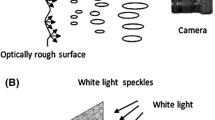Abstract
This paper is concerned with small strain measurement utilizing the numerical processing of digital images. The proposed method has its theoretical basis in digital signal analysis and, from a methodological point of view, it can be considered as an extension to digital images of the wellknown white light speckle photography technique. That conventional method is based on the analysis of photographic plates that are exposed twice (before and after the specimen deformation) with the image of a random speckle pattern that has been previously printed on the test piece surface. The digital speckle correlation advantages consist of requiring a very simple specimen preparation and, mainly, of allowing the strain field computation just by numerical elaboration of the acquired images.
In this paper, the theoretical basis of the technique and some valuable improvements to the known analogous methodologies are presented. Finally, test results for an application of digital speckle correlation are shown and advantages and disadvantages of the technique are elaborated. In addition, further developments in this area are discussed.
Similar content being viewed by others
Abbreviations
- g, p, q :
-
real mono- or two-dimensional signals in the space domain
- G, P, Q :
-
complex spectrum ofg, p andq
- c, C :
-
cross-correlation function and its transform
- j :
-
imaginary unit
- M, N :
-
sub-image dimensions
- m, n :
-
row and column index in the space domain
- h, k :
-
row and column index in the frequency domain
- s h, sk :
-
non-integer shifting values
- u, d :
-
suffixes referring to the undeformed and deformed images
References
Kobayashi, A.S., Handbook on Experimental Mechanics, 2nd edition, Society for Experimental Mechanics, New York (1993).
Amodio, D., Broggiato, G.B. andSalvini, P., “Finite Strain Analysis by Image Processing: Smoothing Techniques,”Strain,31 (3),151–157 (1995).
Amodio, D., Broggiato, G.B. and Santucci, G., “Use of Digital Image Analysis in Strain Field Measurement of Formed Sheets,” AIAS International Conference on Material Engineering, Lecce, Italy (1996).
Sirohi, R.S., Speckle Metrology, Academic Press, New York (1993).
Cloud, G.L., Optical Methods of Engineering Analysis, Cambridge University Press, Cambridge (1995).
Huntley, J.M., Interview on Computer-Aided Analysis of Photographic Specklegrams, Optical Testing Digest, August, SPIE online publication http://www.spie.org/otd (1996).
Sutton, M.A., Wolters, W.J., Peters, W.H., Ranson, W.F. andMcNeill, S.R., “Determination of Displacement Using an Improved Digital Correlation Method,”Computer Vision,1 (3),133–139 (1983).
Chu, T.C., Ranson, W.F., Sutton, M.A. andPeters, W.H., “Applications of Digital-Image-Correlation Techniques to Experimental Mechanics,” EXPERIMENTAL MECHANICS,25,232–244 (1985).
Bruck, H.A., McNeill, S.R., Sutton, M.A. andPeters, W.H., “Digital Image Correlation Using Newton-Raphson Method of Partial Differential Correction,” EXPERIMENTAL MECHANICS,29,261–267 (1989).
Chen, D.J. and Chiang, F.P., Computer Speckle Interferometry (CSI), Proceedings of the International Conference on Hologram Interferometry and Speckle Metrology, 49–58 (1990).
Chen, D.J. andChiang, F.P.,“Optimal Sampling and Range of Measurement in Displacement-Only Laser-Speckle Correlation,” EXPERIMENTAL MECHANICS,32,145–153 (1992).
Chen, D.J., Chiang, F.P., Tan, Y.S. andDon, H.S., “Digital Speckle-Displacement Measurement Using a Complex Spectrum Method,”Applied Optics,32 (11),1839–1849 (1993).
Sjödahl, M. andBenchert, L.R., “Electronic Speckle Photography: Analysis of an Algorithm Giving the Displacement with Subpixel Accuracy,”Applied Optics,32 (13),2278–2284 (1993).
Sjödahl, M. andBenchert, L.R., “Systematic and Random Errors in Electronic Speckle Photography,”Applied Optics,33 (31),7461–7471 (1994).
Sjödahl, M., “Electronic Speckle Photography: Increased Accuracy by Non-Integral Pixel Shifting,”Applied Optics,33 (28),6667–6673 (1994).
Huntley, J.M., “An Image Processing System for the Analysis of Speckle Photographs,”Journal of Physics E: Scientific Instrumentation,19,43–49 (1986).
Author information
Authors and Affiliations
Rights and permissions
About this article
Cite this article
Amodio, D., Broggiato, G.B., Campana, F. et al. Digital speckle correlation for strain measurement by image analysis. Experimental Mechanics 43, 396–402 (2003). https://doi.org/10.1007/BF02411344
Received:
Revised:
Issue Date:
DOI: https://doi.org/10.1007/BF02411344




